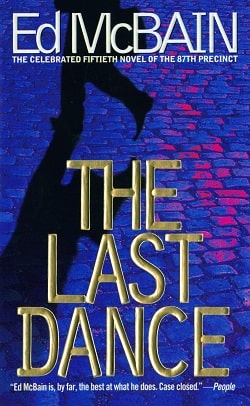Summary

The Last Dance
by Ed McBain
In this city, you can get anything done for a price. If you want someone's eyeglasses smashed, it'll cost you a subway token. You want his fingernails pulled out? His legs broken? You want him more seriously injured? You want him hurt so he's an invalid his whole life? You want him skinned, you want him burned, you want him -- don't even mention it in a whisper -- killed? It can be done. Let me talk to someone. It can be done.
The hanging death of a nondescript old man in a shabby little apartment in a meager section of the 87th Precinct was nothing much in this city, especially to detectives Carella and Meyer. But everyone has a story, and this old man's story stood to make some people a lot of money. His story takes Carella, Meyer, Brown, and Weeks on a search through Isola's seedy strip clubs and to the bright lights of the theater district. There they discover an upcoming musical with ties to a mysterious drug and a killer who stays until the last dance.
.
Read
The Last Dance on http://kissnovel.net
Martial Peak Reviews
Ed McBain's The Last Dance is a gripping entry in the renowned 87th Precinct series, a collection that has long been celebrated for its gritty realism and intricate storytelling. Set against the backdrop of a city where crime is as commonplace as the morning coffee, McBain weaves a tale that is both a murder mystery and a commentary on the darker aspects of human nature. The blurb sets the stage for a narrative that promises not just a whodunit, but a deep dive into the motivations and machinations that drive people to commit heinous acts.
The story begins with the hanging death of an inconspicuous old man, a crime that initially seems trivial to detectives Carella and Meyer. However, as they delve deeper into the investigation, they uncover layers of complexity that reveal the old man's life was anything but ordinary. This duality of perception—where the mundane can mask the extraordinary—serves as a central theme throughout the novel. McBain expertly illustrates how every individual, regardless of their outward appearance, harbors a story that can lead to unexpected consequences.
One of the most compelling aspects of The Last Dance is its exploration of the theme of desperation. In a city where anything can be bought for a price, the characters navigate a moral landscape that is both murky and perilous. The old man's death is not just a murder; it is a catalyst that ignites a series of events driven by greed, ambition, and the quest for power. McBain's portrayal of the seedy underbelly of Isola, with its strip clubs and theater district, serves as a microcosm of society's darker impulses. The juxtaposition of the glitz and glamour of the theater against the grim realities of crime creates a vivid backdrop that enhances the narrative's tension.
Character development is another area where McBain excels. Detectives Carella and Meyer are not mere archetypes; they are fully realized individuals with their own struggles and complexities. Carella, in particular, embodies the moral compass of the story. His determination to seek justice for the old man, despite the apathy surrounding the case, highlights his integrity and commitment to his work. Meyer, on the other hand, brings a contrasting perspective, often questioning the value of their efforts in a city that seems indifferent to suffering. This dynamic between the two detectives adds depth to the narrative, allowing readers to engage with their internal conflicts as they navigate the case.
The supporting characters are equally well-crafted, each contributing to the overarching narrative in meaningful ways. From the shady figures lurking in the shadows of the strip clubs to the ambitious theater producers, McBain populates his world with individuals who are driven by their desires, often at the expense of others. The old man's story, which unfolds through the investigation, serves as a poignant reminder of how lives can intersect in unexpected ways, often with tragic results. The interplay between these characters creates a rich tapestry that enhances the story's complexity and emotional weight.
McBain's prose is sharp and evocative, capturing the essence of the city and its inhabitants with precision. His ability to create a palpable sense of place is one of the hallmarks of his writing. The dialogue is crisp and realistic, further immersing readers in the world of the 87th Precinct. McBain's attention to detail, from the gritty descriptions of the city streets to the nuanced interactions between characters, adds layers of authenticity to the narrative.
As the investigation unfolds, the pacing of the novel remains taut, with each revelation propelling the story forward. McBain skillfully balances moments of tension with quieter, introspective scenes that allow readers to reflect on the moral implications of the characters' actions. The climax is both satisfying and thought-provoking, leaving readers to ponder the consequences of the choices made by the characters throughout the story.
In comparison to other works in the crime fiction genre, The Last Dance stands out for its nuanced exploration of morality and the human condition. While many authors focus solely on the mechanics of the crime, McBain delves deeper, examining the motivations that drive individuals to commit acts of violence. This thematic depth sets him apart from contemporaries and cements his status as a master storyteller.
Overall, The Last Dance is a powerful addition to the 87th Precinct series, showcasing Ed McBain's ability to craft a compelling narrative that resonates on multiple levels. The themes of desperation, morality, and the complexity of human nature are woven seamlessly into the fabric of the story, making it a thought-provoking read that lingers long after the final page is turned. For fans of crime fiction and those seeking a deeper understanding of the human psyche, this novel is a must-read.























Reviews 0
Post a Reviews: